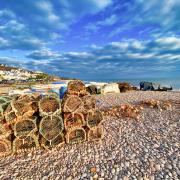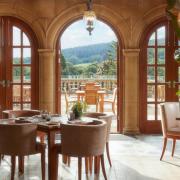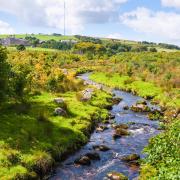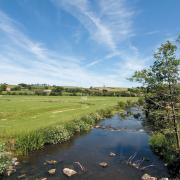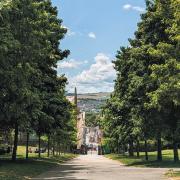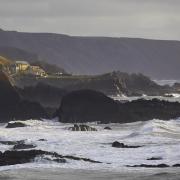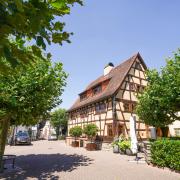It seems so peaceful – the rolling fields and quaint coastal towns full of holidaymakers slurping ice creams and enjoying their slice of life in this rural idyll. But once upon a time, the South Hams was under constant pressure from enemy attack. Its once strategically important towns and ports and thriving export industry has meant centuries of staying on guard. Wartime and unrest were never far away, hence the collection of castles. Dartmouth Castle, Totnes Castle, Berry Pomeroy Castle and Compton Castle – a fortified medieval manor house – still stand today (mostly) as stark reminders of a more turbulent time in this quiet corner of the world.
‘There is definitely a good selection of castles to choose from in this part of Devon,’ says Louise Bartlett, senior properties curator at English Heritage, the organisation that manages historic buildings. Louise oversees the conservation and upkeep of Dartmouth, Totnes and Berry Pomeroy castles. ‘They’re all special in their own way,’ she adds, explaining how the places built to defend the coast and countryside have evolved into much-loved attractions, visited by generations of families.
‘Each one is part of our national history but they’re also part of local and personal histories,’ she says.
Here’s our guide to making the most of these fabulous fortresses…

Totnes Castle
One of the best-preserved examples of a Norman motte and bailey castle in England sits high above the medieval town of Totnes (motte and bailey means a round keep on a raised earthwork).
It’s thought the castle was built as a bit of a show-off move for the Norman lord of the manor, one of William the Conqueror’s commanders. It was probably never meant to withstand a siege, more to suppress any rebellious Anglo Saxons in the busy town below.
The building was originally an earthwork and timber construction, but by the end of the 13th century, it had been rebuilt as a shell keep castle.
Getting here: Be prepared for a climb. Access here is steep slopes and stone steps but the views over town and the River Dart will be totally worth it. You could even run up the last stretch, just as any enemy of the manor might have done before being pelted with arrows.
Must see: Not a huge amount inside the keep and wall but you’ll be too busy looking out and over anyway. The remarkable street pattern of early Totnes can still be seen from the castle ramparts. Look for the curving North Street and South Street with the central High Street and its narrow buildings running downhill to East Gate, the edge of the ‘settlement’.
Make sure you take a walk around the outside wall of the castle to see the steep sided ditch and outer bank, which would have formed part of the original defences.
And another thing: The only small room in the castle is the ‘garderobe’, which acted as storeroom within the southern wall. However, the name was also commonly used to mean toilet (but don’t use it!).

Dartmouth Castle
As once heavily armed fortresses go, this one is very pretty. Dartmouth Castle has guarded the narrow entrance to the Dart Estuary and the port of Dartmouth for more than 600 years. The earliest parts date back to the 1380s when a small enclosure was built after the town was authorised by Richard II to raise funds to improve its defences. This was in response to the threat of attack from France. The castle was also used during the English Civil War, then during the First World War when it was used to protect Britannia Royal Naval College. During the Second World War, Dartmouth Castle housed military troops.
‘We have visitors coming today who tell us that their grandparents were stationed here during the war,’ says Louise. ‘People have this strong association with it.’
Getting there: Dartmouth Castle’s strategic location, right on the edge of the River Dart, makes it one of the most picture-perfect places to get to. If the weather’s fine, you can catch a river boat from the town quay, which lands you just a minute’s walk away from the entrance. The castle is also on the South West Coast Path.
Must see: The gun tower. Climb the four storeys to the open roof platform for a proper lookout’s view. This is the heart of the castle and was designed for guns to fire across the narrowest section of the river. A great iron chain once spanned the water here, which could stop potential enemy ships in their tracks. The winding mechanism for the chain was once located in the tower.
And another thing: The upkeep here is incredible and ongoing. Over the past couple of years, highly skilled stonemasons from Sally Strachey Conservation have used rope access to help carry out a programme of repairs to the castle’s exterior. The team has been removing ivy, loose stonework and re-pointing to help protect and preserve the historic castle walls and the nearby Bayard’s Cove Tudor fort.

Berry Pomeroy Castle
This place has its own cult, or should we say occult, following. The romantic ruin is said to be one of the most haunted places in the UK. The Tudor building was constructed in the 15th century by the Pomeroy family. According to English Heritage, the Pomeroys’ motive for building the castle ‘was all but certainly the disturbed state of Devon, then the most lawless area of southern England’. Local feuds, escalating from 1455 into the conflict later known as the Wars of the Roses, involved the Pomeroys, who were on the Yorkist side.
The family later went on to construct an Elizabethan mansion inside the original castle walls. That building was supposed to be expanded to become one of the most spectacular houses in Devon, but the hugely ambitious project was never finished (an early Grand Designs). By 1700 the castle was an abandoned - and apparently haunted - shell.
Getting here: It’s not far from Totnes Castle. In fact, there’s a 12.5km circular walk you can do between the two (see visittotnes.co.uk) for sturdy types.
Must see: The ghostly goings on. One of the most reported apparitions in the castle is the ‘white lady’, said to be former resident Margaret Pomeroy. She apparently haunts the dungeons of St Margaret’s Tower and has been seen waving to visitors. Other spooky sightings include strange lights and muffled voices.
And another thing: The mansion survives nearly to full height, despite long since losing its roof and upper floors. Louise Bartlett from English Heritage says she has a soft spot for Berry Pomeroy Castle. ‘I love that period of architecture,’ she says. ‘When you visit, you get a real sense of what life would have been like during the Elizabethan age.’

Compton Castle
More fortified manor house than castle, this striking National Trust-managed building with high walls and a portcullis (big, strong gate) was home to the Gilbert family for nearly 600 years. Sir Humphrey Gilbert was the half-brother of Sir Walter Raleigh. It’s still part occupied by Gilbert descendants, so only certain areas of the property are open to the public.
Getting here: Again, just a stone’s throw (no actual missiles, please) from Berry Pomeroy, this is an easy one to include on your castle tour. Please note: Compton Castle is open from April.
Must see: The medieval kitchen. The large cooking fire was a constant danger to the rest of the house and so to reduce the risk, the kitchen was placed in a separate building. The high barrel roof and windows let out any smoke that did not go up the three-flued chimney.
And another thing: Explore the rose garden, orchard and medieval-style knot garden in the castle’s grounds.
nationaltrust.org.uk




